

Engeström's Recent Work - PhD Wiki. Ammendments in red Activity Theory Evolution Engeström (1996) describes a generational evolution of activity theory.
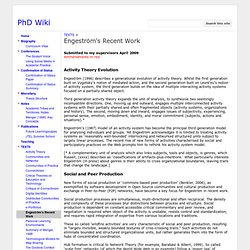
Whilst the first generation built on Vygotsky’s notion of mediated action, and the second generation built on Leont’ev’s notion of activity system, the third generation builds on the idea of multiple interacting activity systems focused on a partially shared object. Third generation activity theory expands the unit of analysis, to synthesise two seemingly incompatible directions. One, moving up and outward, engages multiple interconnected activity systems with their partially shared and often fragmented objects (activity systems, organizations and history). Engeström’s (1987) model of an activity system has become the principal third generation model for analysing individuals and groups. Reijo Miettinen - Selected List of Publications. Soviet Psychology: ACTIVITY AND CONSCIOUSNESS. A.

N. Leontyev 1977 Written: 1972;First Published: 1972, in Voprosy filosofii, no. 12, p. 129-140;Source: Philosophy in the USSR, Problems of Dialectical Materialism, 1977, pp. 180-202;Publisher: Progress Publishers, Moscow;Translated: from the Russian by Robert Daglish;Transcribed: for marxists.org by Nate Schmolze;Proofed: and corrected by Andy Blunden. In examining this problem the first point we have to consider is the question of the significance of the category of activity in any interpretation of how human consciousness is determined.
There are two approaches to this major question. The_Finnish_proposal.pdf (Objet application/pdf) CRADLE - Center for Research on Activity, Development, and Learning - University of Helsinki - Faculty of Behavioural Sciences. Interview with Yrjö Engeström, compiled by Jean Louis Magakian.

Théorie de l’Activité et Management Yrjö Engeström CRADLE, Institute of Behavioral Sciences, P.O. Box 26 (Teollisuuskatu 23) 00014 University of Helsinki, Finland. Dialogue avec Jean Louis Magakian ESC Saint Etienne 51-53 Cours Fauriel 42009 Saint-Etienne, France Médiation, contradiction et zone proximale de développement : trois concepts clés qui constituent les fondements de la Théorie de l’Activité, initiée par Vygotsky et aujourd’hui développée plusieurs chercheurs en sciences cognitives, sciences de l’éducation mais aussi sciences de l’organisation. Le professeur Yrjö Engeström représente une figure dominante de la TA. For the PDF file click here JL Magakian : Quelles sont les principales distinctions épistémologiques entre la Théorie de l’Activité et des courants communément mobilisés en management comme le pragmatisme, la phénoménologie ou l’évolutionnisme ? Collaborative_intentionality.pdf (Objet application/pdf) University of Helsinki - Center for Activity Theory and Developmental Work Research.
Draft of Paavola, S., Engeström, R. & Hakkarainen, K. (2010). Trialogical approach as a new form of mediation (Kai Hakkarainen) An, Kim & Kim 2008; Zhang, Scardamalia, Reeve & Messina 2009; Hong & Sullivan 2009;Lonchamp 2009; van Aalst 2009).The KCM is, however, referred also in many other contexts, like when reviewing variousapproaches to workplace learning and organizational learning (Tynjälä & Häkkinen 2005;Tynjälä 2008), making research on teacher education and teacher communities (Laferriere,Lamon & Chan 2006; Banks 2008; Katz et al 2008; Carroll 2009; Hung et al 2006; Chan & Pang2006), networked learning (De Laat & Lally 2003), development of networked expertise(Edwards, 2005; 2009; Daniels, Leadbetter, Soares, & MacNab, 2006; Mylopoulos & Regehr2009), while defining new digital epistemology for schools and teacher education (Krumswik 2006), or analyzing the nature of open source communities (Hemestberger & Reinhardt 2006).

The KCM is referred in relation to various technologies, like web 2.0 technology moregenerally (McLoughlin & Lee 2008a; 2008b; King et al 2009), or more specifically Wikiversity. Perspectives on Activity Theory: Amazon.fr: Yrjo Engestrom, Reijo Miettinen, Raija-Leena Punamaki, Roy Pea, John Seely Brown, Christian Heath: Livres anglais et étrangers. Soviet Psychology: A.N. Leont'ev. A.N.
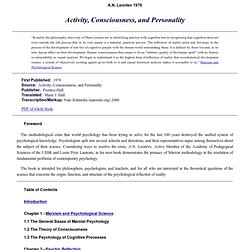
Leontev 1978 Activity, Consciousness, and Personality “In reality the philosophic discovery of Marx consists not in identifying practice with cognition but in recognizing that cognition does not exist outside the life process that in its very nature is a material, practical process. The reflection of reality arises and develops in the process of the development of real ties of cognitive people with the human world surrounding them; it is defined by these ties and, in its turn, has an effect on their development. Human consciousness thus ceases to be an "intrinsic quality of the human spirit" with no history or intractability to causal analysis. University of Helsinki - Center for Activity Theory and Developmental Work Research. Human activity is a complex evolutionary achievement.
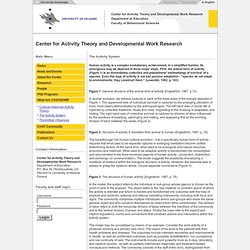
In a simplified fashion, its emergence may be depicted in three major steps. University of Helsinki - Center for Activity Theory and Developmental Work Research. In his Theses on Feuerbach, Karl Marx (1845) pointedly characterized the two pitfalls of social theory: "The chief defect of all previous materialism ... is that the thing, reality, sensuousness, is conceived only in the form of the object or of contemplation, but not as sensuous human activity, practice, not subjectively.

" And on the other hand: "Hence in opposition to materialism the active side was developed abstractly by idealism, which of course does not know real sensuous activity as such. " The cultural-historical theory of activity was initiated a group of revolutionary Russian psychologists in the 1920s and 1930s, determined to turn the spirit of the Feuerbach theses into a new approach to understanding and transforming human life. Learning by Expanding. News Undergrad awarded Student Veteran of the Year Communication undergraduate student, Richard Gilbert, honored as student veteran with the 14th annual Veteran of the Year presented by the UC San Diego Veterans Association along with the dedication of the campus’s new Student Veterans Resource Center (SVRC).
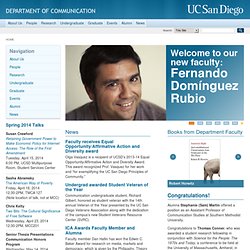
ICA Awards Faculty Member and Alumna Faculty member Dan Hallin has won the Edwin C. Baker Award for research on media, markets and democracy, which is given by the Philisophy, Theory and Critique and the Media Law and Policy Divisions of the ICA. Books from Department Faculty Congratulations! Alumna Stephanie (Sam) Martin offered a position as an Assistant Professor of Communication Studies at Southern Methodist University. Engestrom – Enriching the Theory of Expansive Learning… (2007) « Disruptive Technology Enhanced Learning.
Engestrom (2007) posits a form of learning without the presence of an expert, the kind of learning where the answer is not already known (he uses the term ‘knotworking’).
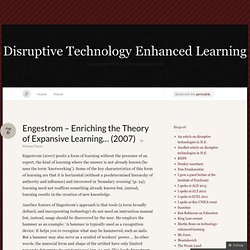
Some of the key characteristics of this form of learning are that it is horizontal (without a predetermined hierarchy of authority and influence) and interested in ‘boundary crossing’ (p. 24); learning need not reaffirm something already known but, instead, learning results in the creation of new knowledge. Another feature of Engestrom’s approach is that tools (a term broadly defined, and incorporating technology) do not need an instruction manual but, instead, usage should be discovered by the user. He employs the hammer as an example: ‘A hammer is typically used as a recognition device: It helps you to recognize what may be hammered, such as nails.
But a hammer may also serve as a symbol of workers’ power….